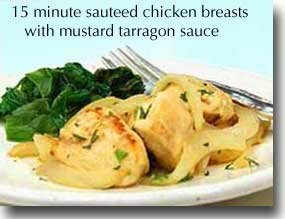If you don't know what to serve for dinner tonight ...
Try this quick-and-easy recipe that combines the great tastes of chicken, Dijon mustard and tarragon to your Healthiest Way of Eating. Fresh herbs are a great way to enhance the taste of your meals and enjoy extra health-promoting nutrients as well.

Ingredients:
- 1 medium onion cut in half and sliced medium thick
- 5 medium cloves garlic, pressed
- 2 boneless, skinless chicken breasts, cut into 1-inch pieces
- 3 TBS Dijon mustard
- 1 TBS + 1/2 cup chicken broth
- 2 tsp honey
- 1 TBS chopped fresh tarragon (or 1 tsp dried tarragon)
- 2 TBS chopped fresh parsley (or 2 tsp dried parsley)
- salt and white pepper to taste
- Slice onion and press garlic and let sit for 5-10 minutes to bring out their hidden health benefits.
- Heat 1 TBS broth in a 10-12 inch stainless steel skillet. Healthy Sauté onion in broth over medium heat for 2 minutes.
- While onions are sautéing, cut chicken into pieces. Add chicken pieces and continue to sauté for another 3 minutes, stirring frequently to seal chicken on all sides. Add garlic and continue to sauté for another minute.
- Add mustard, 1/2 cup broth, and honey. Mix thoroughly and simmer uncovered for about 7-8 minutes on medium-high heat stirring occasionally to cook chicken evenly. This will also reduce sauce.
- While chicken is cooking, chop herbs and add at end with salt and pepper to taste.
- Mediterranean Swiss Chard
In-Depth Nutritional Profile for 15-Minute Sautéed Chicken Breasts with Mustard and Tarragon
Healthy Food Tip
How unsafe is canola oil (rapeseed oil) as far as the issue of trans fats are concerned? What alternatives are there?
Canola oil (provided that it has not been hydrogenated to increase its stability) contains very small amounts of trans fatty acids at levels too low to be a health concern. The levels of trans fat in non-hydrogenated canola oil are below 0.5 grams per serving and qualify for a label claim of "trans fat free." I don't see any reason to shy away from non-hydrogenated canola oil on account of trans fat.
However, to be sure you're getting only this trace level of trans fat from your canola oil, you'll definitely want to check on the ingredient list to make sure that the word "hydrogenated" does not appear. Although you could also check on the Nutritional Facts panel to see if there are 0 grams listed under trans fat, this method isn't full proof, because even though the product may contain some trans fat, the company would be legally allowed to round the number down to 0 grams under certain circumstances (if it contains less than 0.5 grams per serving).
I realize that the Internet has also triggered some concerns about canola oil as a genetically engineered product, and you'll find many Internet websites suggesting that all canola oil is genetically engineered. That's not true. Traditional hybrid cultivation was originally used to produce cooking oil from rapeseed that was low in erucic acid. That low-erucic acid rapeseed (LEAR) oil is the canola oil you buy on the supermarket shelf, and it did not take genetic engineering to produce it. However, since the original release of canola oil into the marketplace, many different forms of genetically engineered canola have been produced. If you want to make sure that you are avoiding all genetic engineering, you're safest step is to purchase organic canola oil. It's still illegal to use genetic engineering in the product of any certified organic product. I prefer organic canola oil for many reasons, including this one.
For more information on this topic, see:
References
Innis SM, Green TJ, Halsey TK. Variability in the trans fatty acid
content of foods within a food category: implications for estimation of
dietary trans fatty acid intakes. J Am Coll Nutr 1999. 18(3):255-60.
Laryea MD, Jiang YF, Xu GL, et al. Fatty Acid Composition of Blood Lipids in Chinese Children Consuming High Erucic Acid Rapeseed Oil. Ann Nutr Metab 1992;36(5-6):273-8.
Muller T, Brancq B, Milius A, et al. Ethoxylated Rapeseed Oil Derivatives As Novel Adjuvants for Herbicides. Pest Manag Sci. 2002;58(12):1243-9.
Naito Y, Konishi C, Ohara N. Blood Coagulation and Osmolar Tolerance of Erythrocytes in Stroke-Prone Spontaneously Hypertensive Rats Given Rapeseed Oil or Soybean Oil As the Only Dietary Fat. Toxicol Lett. 2000;116(3):209-15.
Posada de la Paz M, Philen RM, Abaitua Borda I, et al. Manufacturing Processes at Two French Rapeseed Oil Companies: Possible Relationships to Toxic Oil Syndrome in Spain. Food Chem Toxicol. 1991;29(12):797-803.
Prinz S, Tiefenbach B, Kobow M, et al. Formation of Methanol and Formate in Wistar Rats After Oral Administration of Methylated Rapeseed Oil: a Fuel for Lamps. Clin Toxicol (Phila). 2006;44(2):115-9.
USDA Nutrient Data Laboratory. (2000). Fat and Fatty Acid Content of Selected Foods Containing Trans Fatty Acids. Special Purpose Table No. 1. United States Department of Agriculture, Beltsville, MD.



No comments:
Post a Comment